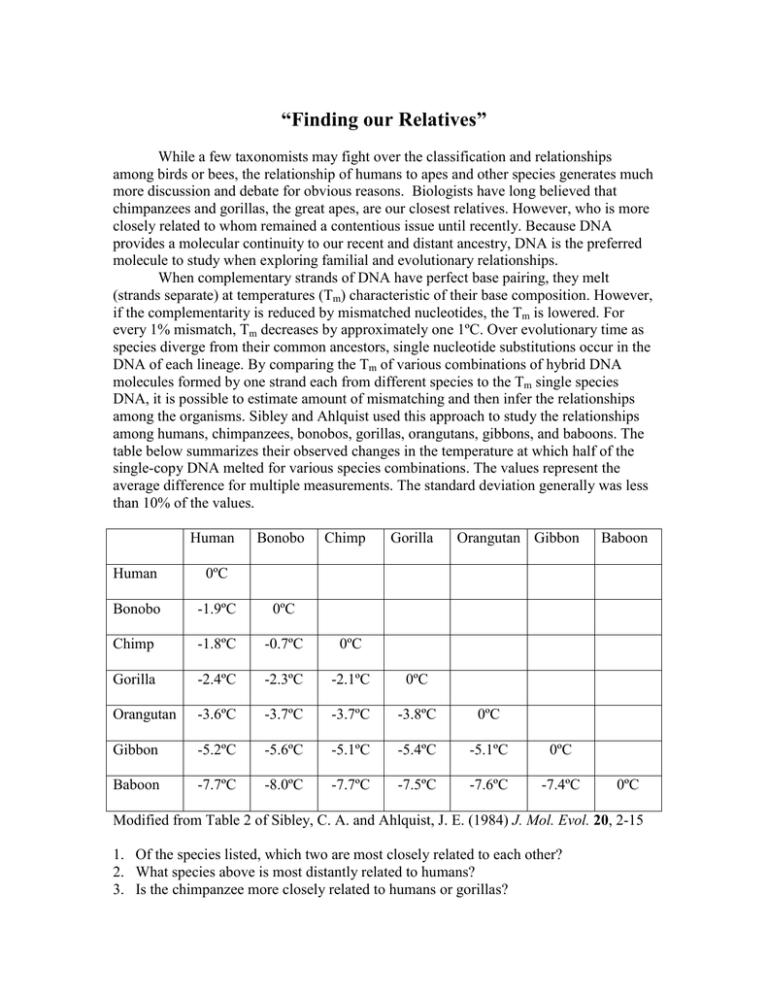“Finding our Relatives”
advertisement

“Finding our Relatives” While a few taxonomists may fight over the classification and relationships among birds or bees, the relationship of humans to apes and other species generates much more discussion and debate for obvious reasons. Biologists have long believed that chimpanzees and gorillas, the great apes, are our closest relatives. However, who is more closely related to whom remained a contentious issue until recently. Because DNA provides a molecular continuity to our recent and distant ancestry, DNA is the preferred molecule to study when exploring familial and evolutionary relationships. When complementary strands of DNA have perfect base pairing, they melt (strands separate) at temperatures (Tm) characteristic of their base composition. However, if the complementarity is reduced by mismatched nucleotides, the Tm is lowered. For every 1% mismatch, Tm decreases by approximately one 1ºC. Over evolutionary time as species diverge from their common ancestors, single nucleotide substitutions occur in the DNA of each lineage. By comparing the Tm of various combinations of hybrid DNA molecules formed by one strand each from different species to the Tm single species DNA, it is possible to estimate amount of mismatching and then infer the relationships among the organisms. Sibley and Ahlquist used this approach to study the relationships among humans, chimpanzees, bonobos, gorillas, orangutans, gibbons, and baboons. The table below summarizes their observed changes in the temperature at which half of the single-copy DNA melted for various species combinations. The values represent the average difference for multiple measurements. The standard deviation generally was less than 10% of the values. Human Bonobo Chimp Gorilla Orangutan Gibbon Human 0ºC Bonobo -1.9ºC 0ºC Chimp -1.8ºC -0.7ºC 0ºC Gorilla -2.4ºC -2.3ºC -2.1ºC 0ºC Orangutan -3.6ºC -3.7ºC -3.7ºC -3.8ºC 0ºC Gibbon -5.2ºC -5.6ºC -5.1ºC -5.4ºC -5.1ºC 0ºC Baboon -7.7ºC -8.0ºC -7.7ºC -7.5ºC -7.6ºC -7.4ºC Baboon 0ºC Modified from Table 2 of Sibley, C. A. and Ahlquist, J. E. (1984) J. Mol. Evol. 20, 2-15 1. Of the species listed, which two are most closely related to each other? 2. What species above is most distantly related to humans? 3. Is the chimpanzee more closely related to humans or gorillas? 4. Is the orangutan more closely related to chimpanzees than to gorillas? 5. Recent comparisons of large regions of human and chimpanzee DNA show a 1.24% incidence of mismatched base pairs. Is this consistent with the melting differences in the above table? 6. Generate a diagram that reflects the relationships among the seven primates. 7. Assuming that mismatches accumulate at a fairly constant rate in different lineages and that the last common ancestor for humans and gorillas lived about 8 million years ago, how long ago did the gibbon and baboon have a common ancestor? Written by H. B. White





